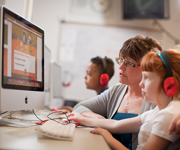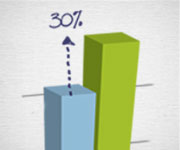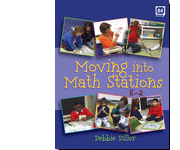Career day teaches students about real-life uses for math A middle school in Wisconsin recently held its first Math in Careers Day. The school invited community members -- including a musician, nurse, carpenter, scientist and cosmetologist -- to teach students how math plays a role in their careers. "We often hear, 'Why do we have to learn this? I'm never going to use this stuff.' Now they see there are people who really do use this stuff across the board," math interventionist Jodi Stanchik said. The Post-Crescent (Appleton, Wis.) (2/4) Students put their skills to the test during Math Field Day About 100 intermediate students from schools in Berkeley County, W.Va., recently competed in Math Field Day. The students took part in a range of activities that tested their math skills, including station-based activities and mental-math questions. "It is a positive process which begins with them becoming more confident -- especially as they begin to feel better about the mental math," teacher Deb Glover said. The Journal (Martinsburg, W.Va.) (2/5) Other News  | Empower Greater Teacher Effectiveness
Learn the five critical questions you must answer in order to unlock the power of students' data, implement the appropriate instructional strategies and empower teacher effectiveness. Download a free white paper. |
 | Calif. district opens after-school program for teens A school district in California used federal funding to create an after-school tutoring and enrichment program called After School Safety and Enrichment for Teens, or ASSET. Some 1,800 high-school students are accessing programs, ranging from academic tutoring to fitness to art. "Tutoring has been the biggest hit," coordinator Jennifer Trindade said. "It's not required, but most kids take advantage of tutoring." Merced Sun-Star (Calif.) (2/4) Other News  | Common Core results are in. In a study of more than 250 urban schools, the schools that used the Ready® program on average had 30% more students score "proficient" on the New York State Assessment in Mathematics—a measure of student mastery on the Common Core—than schools that did not use Ready. See more results and download free sample lessons. | | Mich. lawmakers consider alternative testing vendors Lawmakers in Michigan this week will discuss computer-based exams aligned with the Common Core State Standards that could act as an alternative to the Smarter Balanced exam. There reportedly are more than a dozen available options -- with costs ranging from $11 to $30 per student -- but officials say creating the state's own assessment would be too expensive. Lawmakers say they are walking a fine line in their consideration of alternative vendors because they do not control the test but do provide the money to pay for it. The Detroit News (2/4)  |
In her DVD Moving into Math Stations, K-2, Debbie Diller builds on her best-selling book Math Work Stations, bringing your staff into two real classrooms to see how to use manipulatives, manage time & space, incorporate whole-group instruction, encourage meaningful math talk, and more. View a 7-minute segment online! |
 | Ideas for incorporating the 2014 Olympics into STEM lessons Teachers can tap into students' excitement about the Winter Olympics in Sochi, Russia, by integrating the games into science, technology, engineering and math lessons, freelance Edutopia contributor Matt Davis writes in this blog post. The competition begins Friday, so Davis offers several resources, including videos that share the science behind winter sports, math games provided by Scholastic that feature the Olympics and resources to help students map the torch relay. Edutopia.org/Matt Davis's blog (2/3) | Teaching to win This February is a month of recognizing accomplishments and achievements including the Super Bowl and the Winter Olympics. So what does this have to do with teaching mathematics? Much has been written on the psychology of playing not to lose vs. playing to win. Although the context for this work is usually sports or success in the business world, I am intrigued about the psychology of playing to win as I think about its implications for teaching mathematics. Read more.
Share with MTMS Mathematics Teaching in the Middle School (MTMS) wants you to share your ideas and classroom-tested activities for grades 5–9 that explore statistics and probability. Submit your manuscript by Jan. 6, 2015. What effective methods help students to understand the difference between statistics and probability? In what ways can technology be used effectively to enhance student learning about statistics and probability? More info
|  | History is the unfolding of miscalculation." -- Barbara W. Tuchman, American historian | | | | NCTM SmartBrief aggregates published news and editorial content from diverse sources. The content of NCTM SmartBrief does not necessarily reflect the positions of NCTM or the views of its leadership, and the viewpoints expressed or implied should not be interpreted as official NCTM positions. | Please contact one of our specialists for advertising opportunities, editorial inquiries, job placements, or any other questions.
| Mailing Address:
SmartBrief, Inc.®, 555 11th ST NW, Suite 600, Washington, DC 20004 | | |


No comments:
Post a Comment